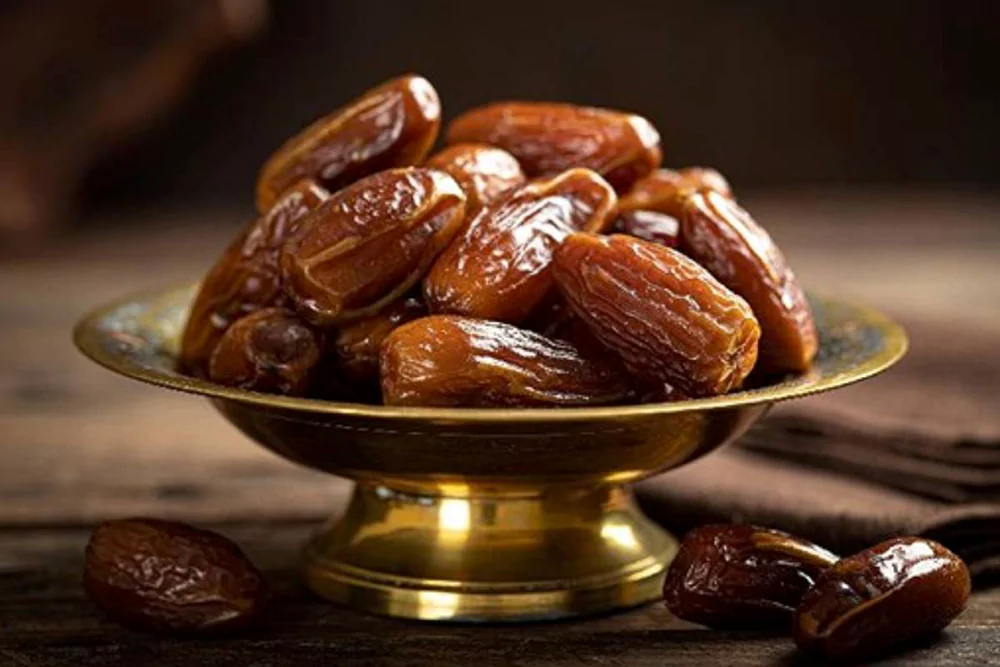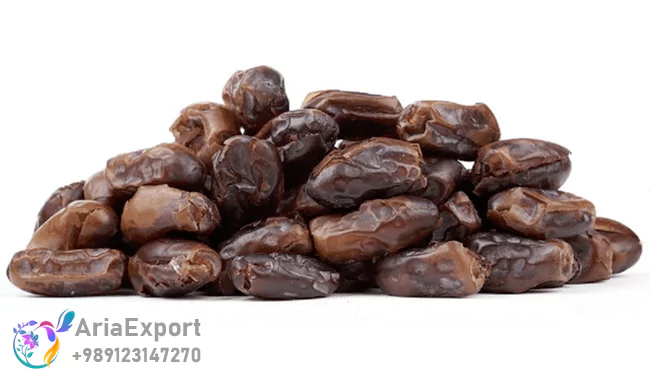
The Sayer Dates or Estaamaran dates, also called Setaamaran in the local language, is one of the export varieties of Iranian dates. The high quality type is grown in Khuzestan province. This date is one of the sweetest Iranian dates, with about 70% sugar content. It has a great export market, and most of it is sent to Europe, North America, Russia, and Oceania countries.
What is Sayer Date?
The Estaamaran or Sayer date, with a brownish color leaning toward black or red, is a semi dry date. However, it has a high sugar content and a very sweet taste. Inside the country, Sayer dates aren’t consumed much, and most of its production is exported. This date is also rich in iron and magnesium, making it helpful for providing iron and improving digestive issues.
This type of date is considered semi dry, with a moisture level of about 15 to 20 percent, which makes it possible to store it for a long time without refrigeration. According to statistics, around fifty percent of Iran's total date exports come from this variety.
If you’re planning to buy Sayer dates, you can check out the "Sayer dates" product right now.

Sayer date has an oval shape, and its color is dark brown, sometimes leaning toward black or red. The Estaamaran dates, due to its high sugar content, dissolves quickly in water and creates a lot of sweetness. (It’s great for baking cakes, desserts, and sweets!) The pit sticks very little to the flesh of the Sayer date, and the pit separates easily from the flesh without any effort. You can also get the pitted version of this date.
It comes in three sizes:
- large
- medium
- small.
Depending on the climate, it might have different flavors, and the amount of syrup in this date is lower compared to other dates.
Read More: Piarom Dates Benefits and Nutrition Facts
Sayer Dates Nutrition Facts and Calories
Sayer dates are a powerhouse of nutrition, offering a rich blend of carbohydrates, fiber, and essential minerals. Known for their high sugar content and energy-boosting properties, these Iranian dates are also loaded with vitamins and antioxidants. The table below provides a complete nutritional breakdown of Sayer dates per 100 grams, highlighting their value as a wholesome snack.
| Nutrient | Amount |
|---|---|
| Calories | 259 |
| Carbohydrates | 78 g |
| Sugars | 68 g |
| Fiber | 12 g |
| Protein | 1 g |
| Calcium | 28-60 mg |
| Iron | 2.6 mg |
| Phosphorus | 50 mg |
| Sodium | 16 mg |
| Magnesium | Present (High) |
| Potassium | Present |
| Vitamin A | Present |
| Vitamin B | Present |
| Vitamin K | Present |
| Antioxidants | High |

Sayer Date Benefits
The benefits of Sayer dates include the following:
- By eating this date after heavy mental or physical activities, you can regain lost energy.
- Sayer dates, like all dates, are full of protein. and packed with nutrients like carbohydrates (78 grams per 100 grams), phosphorus (50 mg), calcium (60 mg), and vitamins A and K, which help keep your skin and eyes healthy.
- Their high fiber protects your digestion, while lots of antioxidants lower the risk of serious diseases, boost your immune system, and fight infections.
- Because of its nice and strong sweetness, this date goes great with drinks like tea or milk.
- Carrying and storing Sayer dates is easy, and they’re perfect for long term use without a fridge, like during sports, hiking, or outdoor activities.
- This date is very useful as a snack or in-between meal for older people, athletes, kids, and pregnant women.

Read More: Mazafati Dates Calories
The most famous city for growing Sayer dates
One of the places where Estaamaran dates are specially grown, and the best quality of this date is found, is Shadegan in Khuzestan. About 13,600 hectares of Shadegan’s land are used for growing Estaamaran palm trees, and around 10,600 hectares of these trees are fully fruitful. But in recent years, back-to-back droughts have hurt these areas, lowering the amount of dates and affecting their quality too. Besides Shadegan, this date is also grown in cities like Ahvaz, Mahshahr, Abadan, and others.
Uses of Estaamaran dates
Since the pit of this date comes off the flesh easily and it dissolves in water without any trouble, you can use it to make all kinds of sweets, drinks, and desserts. I suggest checking out the date cake video on the Zarrin Dates website and making a tasty date cake with this type of date to enjoy with other delicious drinks.
Sayer Dates Types
This type of date is sorted into five groups based on size and quality in workshops, then packaged and sent to the market. Besides Shadegan, this date is also harvested in cities like Abadan, Mahshahr, Karun, and Ahvaz.

- Super Select
- Select
- Grade B
- GAQ
- FAQ
In the table below, we’ve compared the types of these dates:
| Category | Dates per 1 kg | Quality/Size Description | Best Use |
|---|---|---|---|
| Super Select | Max 70 | Largest, carefully picked, no imperfections | Premium quality for end users |
| Select | Max 85 | Slightly smaller, no imperfections | Premium quality for end users |
| GAQ | 110-115 | Smaller, same taste and quality | Affordable option for buyers |
| FAQ | Over 125 | Small, some skin imperfections | Industrial use (cakes, desserts, etc.) |
Read More: Zahedi Dates and Nutrition Facts
Comparison of Sayer Dates with Majool, Piarom, Mazafati, and Zahedi Dates
In the table below, we’ve compared Sayer dates with some of the most famous dates, including Medjool dates, Piarom dates, Mazafati dates, and Zahedi dates:
| Date Type | Shape | Color | Taste/Aroma | Texture | Size (Approx.) | Sweetness Level | Calories (per 100g) | Uses |
|---|---|---|---|---|---|---|---|---|
| Sayer | Oval | Light brown to dark brown | Sweet and mild | Smooth, flesh separates easily from skin | 2.5 to 4.8 cm (length) | High (68 g sugar) | 300 calories | Baking cakes, snacks, energy boost |
| Majool | Large, elongated, cylindrical | Dark brown | Very sweet, caramel-like, honey and cinnamon scent | Soft, juicy, chewy | 5 to 7.6 cm length, 2.5 cm diameter | Very high (68 g sugar) | 277 calories | Raw consumption, baking, sugar substitute |
| Piarom | Large, elongated, slim | Dark brown to black, shiny | Sweet, caramel-like, toffee and nutty scent | Soft, dense, sweet flesh | Large (similar to Majool) | High (assumed similar to Sayer/Majool) | 286 calories | Snacks, desserts, with tea or coffee |
| Mazafati | Medium | Dark, black, shiny | Sweet, soft, meaty | Soft, high moisture (32-35%) | 2.5 to 4.5 cm (length) | Medium (26 g sugar) | 264 calories | Fresh consumption, snacks, table serving |
| Zahedi | Oval, round | Yellow to light brown, sometimes dark | Less sweet than others, still tasty | Firm, dry, low moisture (<14%) | Medium to large, 4-6 cm length, 2-3 cm diameter | Medium to high | About 280 calories | Snacks, export, long-term storage |
Uses and Applications of Sayer Dates
Applications of Sayer Dates in the Food Industry are:
1. Date Syrup Production
Sayer dates, with their high sugar content and mild sweet taste, are perfect for making date syrup. This syrup is used as a natural sweetener in desserts, drinks, and various dishes.
2. Date Paste Production
Thanks to its semi-dry and soft texture, this date is great for making date paste. Date paste is widely used in sweets, cakes, and energy chocolates.
3. Production of Date Chips and Pitted Dates
After pitting, Sayer dates have a long shelf life and are used to make date chips. Date chips are a popular product in the global market.

4. Use in Chocolate and Date Desserts
With its suitable size and good texture, Sayer dates are ideal for making stuffed dates and chocolate-covered dates. This product is used in luxury desserts and healthy snacks.
5. Use in Energy Products
Due to its natural sugar and high energy, this date is used in energy products like energy bars, healthy snacks, and sports drinks.
6. Use in the Export Industry
Sayer dates are one of Iran’s most exported dates. With their long shelf life and processing potential, they’re in high demand in global markets and cost-effective for foreign producers.
AriaExport: Wholsale Supplier & Exporter of Sayer Dates
If you’re looking for Iranian Sayer dates, we at Aria Export provide the best supply and export services for this product. With years of experience in exporting, Aria Export offers valuable services to its customers. For more information, you can contact us and check out the "Price and Purchase of Sayer Dates" page.
